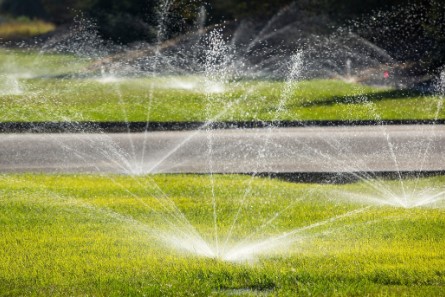In the realm of landscaping, efficient water management is paramount for maintaining lush, healthy greenery while conserving precious resources. One technology that has revolutionized the way we approach irrigation is drip irrigation systems. These systems offer numerous advantages over traditional watering methods, making them a popular choice for homeowners and commercial properties alike. In this comprehensive guide, we will delve into the benefits of drip irrigation systems and explore why they are an excellent investment for your landscape.
What is Drip Irrigation?
Drip irrigation is a method of delivering water directly to the base of plants through a network of tubing, emitters, and valves. Unlike conventional sprinkler systems that spray water indiscriminately over large areas, drip irrigation targets the root zones of plants with precision, minimizing water wastage and maximizing efficiency.
How Drip Irrigation Works
Drip irrigation systems operate by applying water slowly and directly to the soil surface or root zone of plants. This controlled delivery helps to reduce evaporation and runoff, ensuring that plants receive the moisture they need without excess water loss.
Advantages of Drip Irrigation Systems
Water Conservation:
One of the primary benefits of drip irrigation is its exceptional water efficiency. By delivering water directly to the root zone of plants, drip systems minimize evaporation and runoff, resulting in significant water savings compared to traditional sprinkler systems.
Improved Plant Health:
Drip irrigation promotes healthier plant growth by delivering water and nutrients directly to the roots where they are needed most. This targeted hydration encourages deeper root development and reduces the risk of overwatering, which can lead to root rot and other plant diseases.
Reduced Weed Growth:
Because drip irrigation systems deliver water only to designated plant areas, they can help suppress weed growth by depriving unwanted vegetation of the moisture it needs to thrive. This targeted watering also minimizes soil disturbance, further inhibiting weed germination.
Customized Watering:
Drip irrigation systems offer unparalleled flexibility in watering schedules and durations, allowing you to customize irrigation patterns based on the specific needs of your landscape. Whether you have drought-tolerant plants or moisture-loving specimens, drip systems can be tailored to meet their individual watering requirements.
Minimized Soil Erosion:
Traditional sprinkler systems can contribute to soil erosion by delivering water at high pressure, leading to runoff and soil displacement. Drip irrigation, on the other hand, applies water slowly and gently to the soil surface, reducing the risk of erosion and preserving the integrity of your landscape.
Factors to Consider Before Installing Drip Irrigation
Landscape Layout and Design:
Before installing a drip irrigation system, it’s essential to assess your landscape layout and design to determine the most efficient placement of emitters and tubing. Factors such as plant density, slope, and soil type will influence the system’s effectiveness and water distribution.
Soil Type and Slope:
The composition of your soil and the slope of your landscape can impact water absorption and distribution. Sandy soils, for example, may require more frequent watering intervals, while clay soils may retain moisture longer. Similarly, slopes can affect water flow and distribution, requiring careful planning to prevent runoff and pooling.
Plant Types and Watering Needs:
Different plants have varying water requirements, so it’s essential to consider the specific needs of your landscape’s vegetation when designing your drip irrigation system. Drought-tolerant plants may require less frequent watering, while thirsty specimens may need more frequent hydration.
Budget and Installation Costs:
While drip irrigation systems offer long-term water savings and environmental benefits, it’s essential to factor in the initial installation costs when planning your project. Budget considerations may influence the type of system you choose, as well as the extent of coverage and additional features such as timers and moisture sensors.
Drip Irrigation Installation Process
Planning and Design:
The first step in installing a drip irrigation system is to develop a comprehensive plan that takes into account your landscape’s layout, plant types, and watering needs. This involves mapping out the location of plants, determining water flow requirements, and selecting appropriate materials and components for the system.
Material Selection:
Once the design is finalized, the next step is to select the necessary materials for the installation. This includes drip tubing, emitters, connectors, valves, filters, and pressure regulators, all of which play a crucial role in delivering water efficiently to your plants.
Installation Steps:
The installation process typically involves laying out the drip tubing according to the predetermined design, securing it in place with stakes or anchors, and connecting it to a water source. Emitters are then installed at the base of each plant, delivering water directly to the root zone. Finally, the system is tested and adjusted to ensure proper operation.
Maintenance Tips for Drip Irrigation Systems
Regular Inspections:
To keep your drip irrigation system in optimal condition, it’s essential to conduct regular inspections to check for leaks, clogs, and other issues that may affect performance. Inspect tubing, emitters, and connections for signs of wear or damage, and replace any faulty components as needed.
Cleaning Filters and Emitters:
Over time, filters and emitters can become clogged with debris, affecting water flow and distribution. Clean filters and emitters periodically to remove any buildup and ensure proper operation. This will help maintain consistent water delivery to your plants and prevent potential damage to the system.
Seasonal Adjustments:
Adjust your drip irrigation system seasonally to accommodate changes in weather and plant growth. During hot summer months, for example, you may need to increase watering frequency, while in cooler seasons, you can dial back irrigation to prevent overwatering and conserve water. Monitor weather patterns and adjust your system accordingly to avoid under or overwatering, ensuring optimal plant health throughout the year.
Repairs and Troubleshooting:
Despite careful maintenance, drip irrigation systems may encounter occasional issues such as leaks, clogs, or damaged components. Promptly address any problems that arise by identifying the source of the issue and implementing necessary repairs. This may involve replacing damaged tubing, emitters, or connectors, or adjusting water pressure and flow rates to restore proper functionality.
At Rototillerguy Landscaping, we specialize in irrigation installation and maintenance services, helping clients in Los Angeles County and surrounding areas achieve lush, vibrant landscapes that thrive year-round. With our expertise and dedication to quality workmanship, we can design and install a customized drip irrigation system tailored to your landscape’s unique needs, ensuring optimal water efficiency and plant health.Whether you’re looking to upgrade your existing irrigation system or embark on a new landscaping project, trust Rototillerguy Landscaping to deliver exceptional results and unparalleled service. Contact us today to learn more about the benefits of drip irrigation and schedule a consultation with one of our experienced professionals. Enhance your landscape with the power of drip irrigation and experience the difference it can make for your property.
Conclusion:
drip irrigation systems offer numerous benefits for landscape management, including water conservation, improved plant health, reduced weed growth, customized watering, and minimized soil erosion. By considering factors such as landscape layout, soil type, plant needs, and budget, homeowners and landscapers can design and install efficient drip irrigation systems that enhance the beauty and sustainability of their landscapes.
With proper maintenance and occasional adjustments, drip irrigation systems can provide long-lasting benefits while preserving water resources and promoting healthy plant growth. Trust Rototillerguy Landscaping for expert insights and installation services to optimize your landscape’s irrigation efficiency and sustainability.





